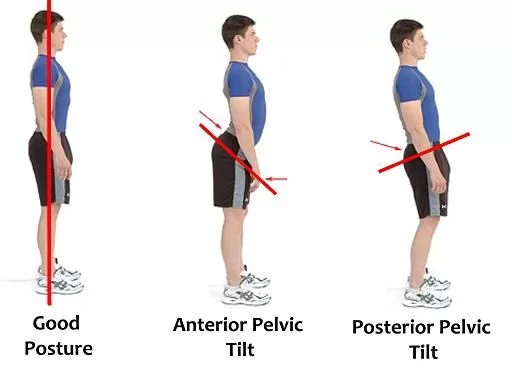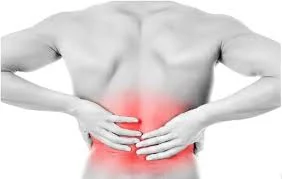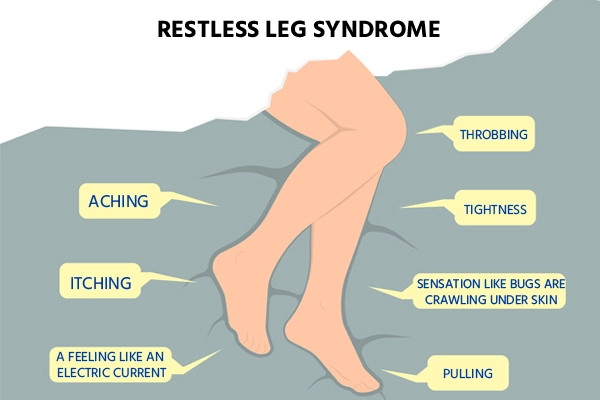How To Fix Posterior Pelvic Tilt?
Table of Contents
A Posterior Pelvic Tilt: What Is It?
A condition known as posterior pelvic tilt occurs when the pelvis rotates upward, rising in the front and falling in the rear.
The way your pelvis is positioned has a big impact on how well your lower back and spine align. An imbalance between the muscles of the legs and the muscles of the core results in posterior pelvic tilt. It may result in many painful symptoms, including back discomfort and tight hamstrings.
Exercises designed to target certain muscles and adjustments to sleeping and sitting positions that support the lower back are possible treatment options.
The causes and symptoms of a posterior pelvic tilt are covered in this article. Treatment is also covered, with exercises to try and suggestions for changing how you sit and sleep.
Posterior Pelvic Tilt: What Causes It?
Several factors might cause posterior pelvic tilt, but muscular spasm is the most frequent cause. Numerous muscles in and surrounding the lower back serve as protectors and stabilizers, and when the back is strained, these muscles are compelled to contract and lock up. The glutes are the main muscles that tighten up and cause the pelvis to tilt posteriorly; we will address these issues in detail in the workouts that follow.
Straining activities are usually the cause of posterior pelvic tilt. Stretching your lower back’s capacity with high-rep exercises in the gym, lifting items all day while performing manual labor, or playing a high-impact activity without adequately warming up can all lead to PPT. Burpees (of all things… burpees really?) at the end of a strenuous circuit workout that included sprints, bodyweight squats, pushups, and burpees without warming up and going as fast as one could for the time was the cause of my most recent posterior pelvic tilt.
- Incorrect seat dimensions
- Pelvic instability
- Fatigue
- Limited hip flexion
- Tight hamstring muscles
- Weak abdominals/ back extensors
- Abnormal muscle tone
- Lack of adequate foot support
Improper Posture while Standing
Correct standing posture is just as important as appropriate sitting posture. You may have a posterior pelvic tilt posture if you discover that when you stand, your shoulders hunch, and your lower back arches.
Taking up/Transporting Heavy Items (Like a Baby!)
Additionally, if you are holding heavy goods for lengthy periods, you may acquire a posterior pelvic tilt. Your tailbone will often lean forward, or “under,” as your hips attempt to hold the “heavy object.”
Your back gets longer as a result, and your abdominal muscles get shorter. This will eventually lead to severe postural issues.
Inappropriate Workout Programme
You may be increasing your risk of posterior pelvic tilt if your workout regimen emphasizes building your hamstrings, gluteals, and abdominal muscles. The natural curvature of the lumbar spine can be flattened when the overdeveloped abdominal muscles drag the pelvis posterior to the counterbalancing back muscles.
Sleeping Posture
A pelvic tilt may occur if your mattress or sleeping posture interferes with your spine’s natural curvature.
What Are the Signs of Posterior Pelvic Tilt?
You can use these easy tests to determine whether you have a posterior pelvic tilt.
In Standing:
Test for posterior pelvic tilt
Guidelines:
- Get to your feet.
- The pointed bone at the front of your pelvis is called the Anterior Superior Iliac Spine (ASIS). Place one finger on it.
- Apply pressure with a second finger on the PSIS (Posterior Superior Iliac Spine).
- The pointed bone at the rear of your pelvis is this one.
- Compare these two landmarks’ heights.
- If your pelvic tilt is posterior, then: Compared to the finger on the pointed bone at the rear, the finger on the front of your hip bone will be much higher.
(Remember: Everybody has unique “pointy bones” of varying sizes and shapes. This might affect the outcome.)
While squatting, sitting, or bending forward:
Take note of your lower back’s curvature.
Your pelvis is probably tilted backward if the typical arch in your lower back is reduced.
Is A Pelvic Tilt towards the Posterior Harmful?
No, having a tilt to the posterior pelvis is not always “bad.”
(Many persons with posterior pelvic tilt have no symptoms!)
But when the pelvis becomes stuck in this position routinely, there may be problems associated with a posterior pelvic tilt. Your entire posture can be greatly impacted by your pelvic position.
The lumbar spine’s natural curvature (Hypolordosis) will be lost when the pelvis tilts backward.
Your lower back’s natural arch helps protect the lumbar spine from developing problems like these:
- Disc Bulges
- Sciatic Nerve Issues
- Muscular strains
How To Fix Posterior Pelvic Tilt?
Can the posterior pelvic tilt be corrected? First, a client’s natural lower back curve may be used to determine whether or not they have problems with posterior pelvic tilt. When there is no inherent bend in the lower back, you have a posterior pelvic tilt. Even the location of the posterior superior iliac spine relative to the anterior superior iliac spine may be determined.
By feeling for the two bony markers in the lower back, one may locate the posterior superior iliac spine, which is located in the rear of the pelvis. As seen here, the anterior superior iliac spine is located at the front. They should have a tiny decrease from front to rear, thus if the two are almost horizontal to one another, this may indicate posterior pelvic tilt.
If a client’s posterior pelvic tilt is discovered, you must create a corrective exercise program to address the problems. This program should focus on releasing the hamstrings, abdomen, and glutes that are overly tight and active. It’s also important to think about strengthening your weak lumbar erectors and hip flexors.
Exercises for Posterior Pelvic Tilt
When creating a program for posterior pelvic tilt, incorporate these corrective exercises into it:
- Stretching tight hamstrings when seated might cause the pelvis to tilt back.
- Superman: bolsters the lumbar spine and weak gluteal muscles
- Cobra: Relaxes tense abdominal muscles and is excellent for extending the psoas muscle, which pulls your pelvis forward.
- Strengthen your weak hip flexors using leg raises.
- To strengthen weak hip flexors, perform standing hip raises.
- Figure 4: Release tense glute muscles with the gluteal stretch
- Good morning: Promote anterior pelvic tilt and hip hinge movement.
- Release tense glutes with the Glute/Priformis Foam Roll.
- Roll Your Hamstrings to Release Tightness
- You must strengthen your glutes, abdominals, and hamstrings to correct the posterior pelvic tilt.
- Pelvic tilt in the posterior, anterior, and lateral directions
- Release tense glutes with the Glute/Priformis Foam Roll.
- Roll Your Hamstrings to Release Tightness
You must strengthen your glutes, abdominals, and hamstrings to correct the posterior pelvic tilt.
Posterior Pelvic Tilt vs Anterior Pelvic Tilt
Pelvic tilts come in more varieties than only posterior pelvic tilts. Anterior pelvic tilt and lateral pelvic tilt are the other two. The name of each is derived from the pelvic position.
When the pelvis tilts forward, it is called an anterior pelvic tilt. During this position, the back of the pelvis is higher than the front. This can cause discomfort since it increases the lower back’s curvature.
Additionally, an anterior tilt may change the lower body’s range of motion, which may raise the risk of injury. An anterior pelvic tilt, for example, has been linked to an increased incidence of hamstring injuries in football players, according to one research. The fact that it kept its knee extended explains why.
When the patient has lateral pelvic tilt, one side of an individual’s pelvis sits higher than the other. Hip and lower back pain are linked to this posture. Walking and running balance may also be affected.
Exercises for Posterior Pelvic tilt
Rebalancing the muscles that are causing the aberrant pelvic alignment is the most effective technique to repair a posterior pelvic tilt. Stretching is necessary to restore the flexibility of chronically tense muscles. On the other hand, weak muscles must be strengthened.
Stretching is mostly recommended for the hamstrings and abs.
The deep core muscles, hip flexors/quadriceps, and glutes are the primary regions that may require strengthening.
Superman exercise
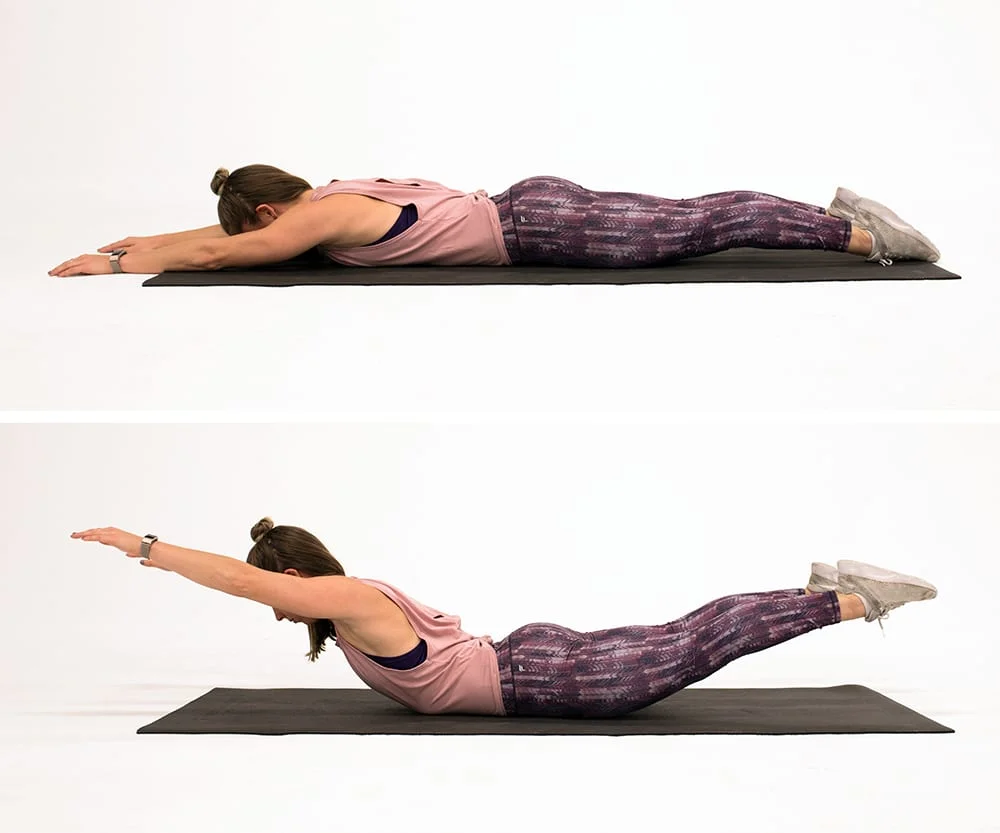
The reason this exercise is named the “Superman” is because it resembles a superhero in midair. It can help to strengthen the muscles in your lower back, gluteus maximus, along with pelvis.
How-to
- Extend your arms in front of you while lying on your stomach on the floor.
- Try to keep your chest up above the ground for ten to thirty seconds. Next, decrease.
- After every set, take a 10-second pause and repeat this three times.
Be cautious: It’s better to avoid this workout if you have back problems. For added comfort, you might wish to place a mat or towel on the floor before beginning this exercise.
Lunges
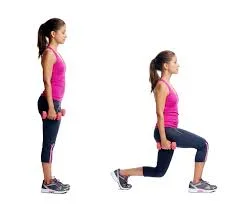
You may strengthen your quadriceps and glutes by doing lunges.
How to carry it out:
- Start by placing your feet together while standing.
- Step forward with your left leg.
- Your left leg should be bowed to a 90-degree angle, and your right knee should be in contact with the floor.
- Lift your left leg and reposition yourself to the beginning position.
- On your right side, repeat.
- 3 sets of 10 lunges on each side should be the goal.
- When in the lunge posture, make sure your knee does not go above your toe’s level since this puts additional strain on the knee.
Cobra stretch
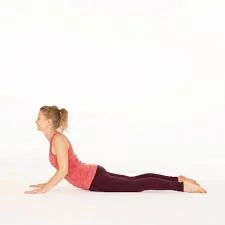
The upright posture of the dangerous cobra snake gives name to this stretch. The Cobra pose is excellent for a posterior pelvic tilt as the front body prolongs because it activates the hamstrings, glutes, as well as back muscles.
Better posture and lower back pain are supported by more flexible spines, especially for those who have menstruation pain, which inherently makes you want to slouch.
The procedures
- Place your belly down on the mat to begin. Point your toes, adjust your legs together with your hips, and take a profound breath sometime recently moving on to another workout.
- Thrust yourself off the ground by twisting your elbows tenderly until you’re feeling your back amplify.
- Use your hands and wrists to sustain your weight for a duration of 15 to 30 seconds. Be careful not to flex your elbows at this point.
- Breathe deeply and slowly into and out of the pose.
Be careful: If you want a modified version of the Cobra posture that doesn’t strain your neck or back as much, keep your elbows bent and your tummy on the floor. Bring your chin down to a comfortable level and look straight and forth.
Foam rolling for calves
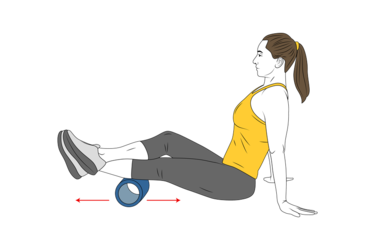
Foam rolling, also known as self-myofascial release, is similar to massage treatment. It’s a fantastic way to help release tension in different areas of your body after working out. Foam rollers are available online and at sports goods stores.
The fascia, or connective tissue, beneath the skin that is required for healthy mobility, is loosened by foam rolling.
Although you may foam roll any area of your body, posterior pelvic tilt may be improved by concentrating on your legs.
The procedure
- Place the foam roller beneath your calf region while lying on your side.
- Roll the foam roller up your calf slowly, paying attention to any “hot spot.” You experience increased stiffness or tension in this region.
- Give this region a 30-second rollover.
- Change legs and repeat the motion. Apply the same technique to your thighs as well.
- Lying on your back, roll the foam roller up the back of your leg for increased pelvic concentration and benefits.
- Move the foam up your hamstrings and in the direction of your glutes. Choose a hot location to sit on and concentrate your rolling there. Alternate legs and repeat.
- Foam rolling can feel soothing and act as a kind of massage, even if you could occasionally experience discomfort. You may also massage your spine and use foam rolling across your middle back.
Seated Hamstring Stretch
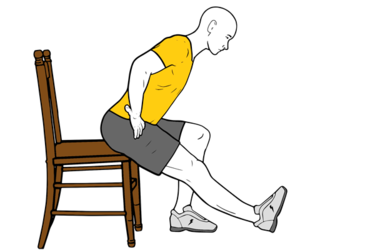
Long periods of sitting and standing can cause hamstring tightness, which can result in bad postures such as posterior pelvic tilt. Your hamstring will extend as a result of stretching, which will help your body maintain a more neutral pelvic posture.
- How to carry it out:
- Start by sitting down on a firm chair.
- Your left leg should be extended in front of you.
- Reach for your toes with a forward bend until you feel a tiny stretch.
- Hold onto this position for 15 to 20 seconds at least.
- Revert to the starting position gradually.
- On your right side, repeat.
- Try to complete three reps on each side.
Leg Raises
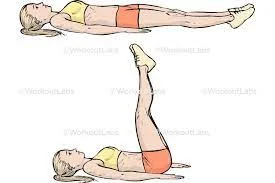
Leg raises assist in strengthening your hip flexors, which might weaken due to the pelvic posterior tilt.
How to perform it:
- Lie down on the floor with your legs extended at the beginning.
- Keeping your arms straight at your sides, slowly raise your legs off the ground by contracting your abdominal muscles. This will cause your lower back to curve and make an arch.
- Gradually bring your legs back to the starting position.
The secret to this workout is to solely move your legs; this will help your core muscles strengthen. This is a challenging workout; if you have trouble raising your legs, consider bending your knees a little.
Toe Touch
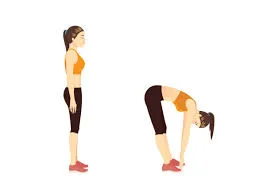
- Start by arranging your legs shoulder-width apart.
- Aim for your toes while bending forward at the hips.
- Your hips and feet should line up exactly.
- Hold this stance for 20 seconds without bouncing.
Slouch-Overcorrect
- Avoid reclining in a chair for support.
- Lean your back forward slowly.
- For a few seconds, hold this posture unless you experience any pain. If so, take a seat again upright.
- Verify that your feet are securely set in the ground.
- Start sitting up as straight as you can slowly. Remember that this may cause your shoulders or lower back to feel a little tense.
- For a short period, maintain this stance.
- Release slowly into a more at-ease, upright position. If there is a sense of stress, it should be removed.
- Ten times over, repeat.
Further Methods for Correcting Posterior Pelvic Tilt
There are other methods for correcting a posteriorly tilted pelvis besides pelvic tilt exercises. In case you usually sleep on your stomach, shifting positions might help with the alignment of your pelvis. Proper spinal (and pelvic) alignment is supported when sleeping on your back. For extra support, you can alternatively sleep on your side with a cushion between your knees.
Make advantage of lumbar support when seated. This feature, which lets you customize the amount of support to your liking, is available on some chairs. For those who don’t, a cushion could work as a substitute. Additionally, get up and walk about frequently if you spend a lot of time sitting down, including when driving or at a desk.
By becoming a Corrective Exercise professional, you may find out more about how to assist clients who have pelvic tilts.
Sleeping Adjustments
To assist in maintaining proper posture as you sleep
- Steer clear of sleeping on your stomach.
- If you want to sleep on your back, put a little cushion behind your knees.
- Put a cushion between your knees and create some distance if you prefer to sleep on your side.
- If you sleep on your back, place a small cushion or rolled towel behind the arch of your back.
- Make sure your mattress and pillow accommodate your spine’s natural curvature.
- Ask your physical therapist or other healthcare expert for advice if you’re unsure about the kind of cushion or mattress that will suit your needs the best. Generally speaking, your pillow and mattress should accommodate the natural curvature of your spine and never cause pain or discomfort upon waking.
Handling Pelvic Tilt in the Back While Sitting
Whether you sit apart at work or fair all the time, it’s vital to guarantee:
- You are seated on a chair that promotes good posture.
- The work area or table you select permits you to sit up straight and maintain a strategic distance from slumping.
- For lumbar support, you may either use a cushion or a chair that already has this kind of support built in.
- You take the time to extend and get up and around, especially in case you spend a part of your time sitting down.
Are there any helpful alternatives to seating accessible?
The outcome of a thorough evaluation will determine if the posterior pelvic tilt is fixed or correctable and how it should be managed. The goal is to maintain the pelvis in all planes of motion; the pelvis controls the movement of the body both above and below, making it an essential component of a secure sitting posture. Among the seating options are:
- Make sure the seat height and depth are appropriate
- When suitable, a tilt-in-space or ramped base can promote pelvic stability and energy management. After a risk assessment, a pelvic belt may also be taken into consideration.
- adjusting the back angle to take into account the hip range of motion
- and a curved back to maintain the spine’s natural form
- ensuring that the foot support is positioned correctly
- Make sure the elevating leg rest is used appropriately based on the length of the hamstring muscles
- addressing any thoracic kyphosis that may have arisen or resulted from it
Overview
Maintaining your health requires movement. Lack of activity and a sedentary lifestyle might raise your risk of back discomfort, bad posture, and other conditions. These easy workouts can help your body move more efficiently, stand taller, and sustain itself regularly.
Your spinal health may be negatively impacted by a posterior pelvic tilt. You’ll be well on your way to a more neutral pelvic posture and a healthier spine by lengthening and strengthening shortened and tight muscles.
Although they might vary, symptoms can include backache, hamstring tightness, and slouched posture. Therapy often involves workouts that target typical muscles, as well as bedtime position and sitting transformations.
FAQs
Your posterior pelvic tilt [PPT] might have three probable causes: weak hip flexors and/or lower back muscles, stiffness in the hamstring and/or abdominal muscles, or—more likely—a combination of all three.
Treatment options for pelvic tilt may include surgery or nonsurgical measures. Pelvic tilt can be corrected using minimally invasive surgery during adult deformity surgery. Exercises that tilt your pelvis can also strengthen your muscles and put your pelvis back in a neutral posture.
In terms of pelvic tilt, 85% of men and 75% of women showed an anterior tilt, 6% of men and 7% of women showed a posterior tilt, and 9% of men and 18% of women showed a neutral tilt.
Muscle imbalances and pelvic tilt are common in today’s customers. Yoga has several advantages that can assist in guiding clients toward improved alignment for improved movement, functionality, and performance. Keep in mind that doing a yoga posture correctly is just as vital as performing the pose itself to support alignment.
A posterior rotation of the innominates is indicative of a posterior pelvic tilt. When this happens, the person often has an extremely flat back and ‘tucked under’ buttocks.
References
- 5 Exercises to Fix Your Posterior Pelvic Tilt. Healthline. https://www.healthline.com/health/posterior-pelvic-tilt#superman-stretch
- 9 Best Exercises for Correcting Posterior Pelvic Tilt | https://www.issaonline.com/blog/post/9-best-exercises-for-correcting-posterior-pelvic-tilt
- How to Correct Posterior Pelvic Tilt: The Greatest Exercises & stretches. Back Intelligence. https://backintelligence.com/fix-posterior-pelvic-tilt/
- What Is a Posterior Pelvic Tilt? Verywell Health. https://www.verywellhealth.com/posterior-pelvic-tilt
- Corrective Exercises, Causes, Finding Relief. Back Muscle Solutions.
- https://backmusclesolutions.com/blogs/the-ql-blawg/posterior-pelvic-tilt
- How Do You Correct a Pelvic Tilt? Types & Exercises. MedicineNet. https://www.medicinenet.com/how_do_you_correct_a_pelvic_tilt/article.htm
- CareFlex. https://www.careflex.co.uk/health/posture/posterior-pelvic-tilt/

